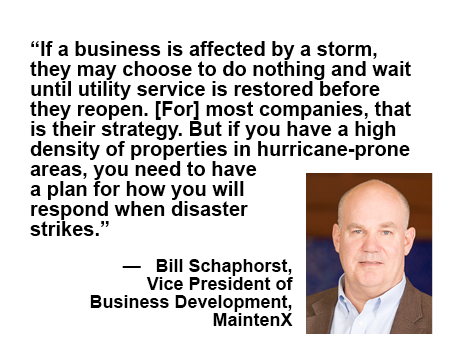The increasing frequency and intensity of natural disasters pose a growing threat to many restaurants and retailers. All too often, unprepared businesses struggle to contend with property damage, power interruptions and repair delays that can plague communities for months in the wake of a catastrophic wildfire or storm.
“Businesses that have stores operating in hurricane-prone areas like Florida or other regions threatened by natural disasters need to have a plan in place, with committed assets or a vendor to support them in an emergency,” says Bill Schaphorst, vice president of business development at facilities repair service provider MaintenX.
“A plan should tell them, No. 1, how to take care of their people and ensure they are safe,” Schaphorst says. “No. 2, a plan should lay out expectations for after the storm. How quickly can the stores reopen? How will the company staff locations in damaged areas and make repairs to resume operations?”
Rising Risk
From drought-fueled wildfires throughout the West and Midwest to extreme winter and summer temperatures straining electrical grids in the Deep South and overactive hurricane seasons pounding the Gulf States and East Coast, shifting weather patterns are raising threat levels coast to coast. For Tampa, Florida-based MaintenX, which serves clients from the Carolinas to California, hurricanes are the primary threat to customers’ operations.
“The Atlantic Ocean is heating up and providing the fuel for these hurricanes, causing a higher frequency of storms and also making them stronger,” Schaphorst says.
For example, Hurricane Beryl, which knocked out power to millions of homes and businesses in and around Houston this past July, entered the record books as the earliest Atlantic hurricane to reach Category 5 status and only the second July storm on record to reach that intensity, forming two weeks earlier than 2005’s Hurricane Emily, according to the National Hurricane Center.
As hurricane risk trends from possible to probable over time, more and more companies are investing in portable generators and service contracts to get their stores and eateries back in service quickly after a disaster. Retailers that sell pharmaceuticals, fuel or groceries, for example, can provide vital services to storm-ravaged communities by reopening quickly.
Other retailers that prepare a disaster response may be motivated to capture storm-related customer demand and perhaps grow market share by operating while competitors remain closed, pending repairs or the restoration of municipal power. Disaster planning for a home improvement retailer, for example, will likely include fortifying pre-storm inventories of plywood, fuel, sandbags and other materials used in storm preparation and cleanup. Discount clothing stores able to reopen in the wake of damaging storms often register elevated sale volume as residents restock damaged wardrobes.
Plan and Prepare

MaintenX
“Make sure you have a disaster plan in place before a disaster occurs,” says Herman Wilkinson, vice president of service operations at MaintenX. “MaintenX has four to five disaster meetings per year to go over our disaster plan. We like to do pre-disaster and post-disaster meetings. The purpose of the pre-disaster meeting is to be prepared for when disaster occurs. The reason for the post-disaster meeting is to review what went well and what we can do to improve ahead of the next disaster.”
MaintenX traces its disaster preparedness programs to the example of a client and major drugstore chain that it began serving some two decades ago. Power outages or the loss of an HVAC system can ruin pharmaceutical inventories, Schaphorst explains, and access to prescription medications is critical for retail customers who may struggle with limited resources after a storm. In addition to contracting with MaintenX for maintenance and repairs including storm response, the drugstore chain also invested in its own generators to help bring stores back online quickly.
Today, MaintenX keeps roughly 150 generators ready for rapid deployment to client properties that lose power. Demand for generators is often intense during a crisis, and customers get the first opportunity to lease MaintenX’s units before the company makes them available to new clients.
MaintenX delivers generators by trailer to client sites and employs experienced electricians to connect them to the client’s electrical service panel. Company fuel trucks return daily to refill each generator until local utility service is restored. A MaintenX crew then switches the client back to municipal power and retrieves the generator.
Whether a retailer employs its own maintenance personnel or contracts with an outside firm, it is a good idea to have a maintenance and repair professional inspect buildings for readiness when a major storm is imminent.
“There is always a high demand for pre-hurricane services,” Schaphorst says. “We make sure nothing is clogging the downspouts and drains, so water won’t be pooling on the roof or in the loading dock. We also make sure there is nothing loose or lying around on the roof. A loose piece of metal that gets blown around can cause tremendous damage to rooftop equipment.”
Sandbags to repel floodwaters are another cost-effective safeguard, particularly for properties in low-lying areas. MaintenX owns a machine to fill the sandbags it deploys to customer locations. When the crisis has passed, MaintenX crews return to remove the sandbags.
Not surprisingly, much of the work required to bring stores and restaurants back online after a disaster involves HVAC repairs or replacement of damaged systems. Following a hurricane or similar regional event, surging demand for spare parts and skilled technicians can rapidly deplete inventories and tie up repair crews for months. That’s why Schaphorst advises businesses to contract with a capable service provider to ensure access to timely repairs when needed.
It is up to each company to choose the preparations and response measures appropriate to its needs. Purchasing or leasing generators, fortifying buildings and expending capital and human resources to resume operations while the surrounding community is still reeling from a natural disaster can be an expensive undertaking, Schaphorst says.
“If a business is affected by a storm, they may choose to do nothing and wait until utility service is restored before they reopen. And for most companies, that is their strategy,” he observes. “But if you have a high density of properties in hurricane-prone areas, you need to have a plan for how you will respond when disaster strikes.”
— By Matt Hudgins. MaintenX is a content partner of Retail & Restaurant Facility Business. For more articles from and news about MaintenX, click here.

